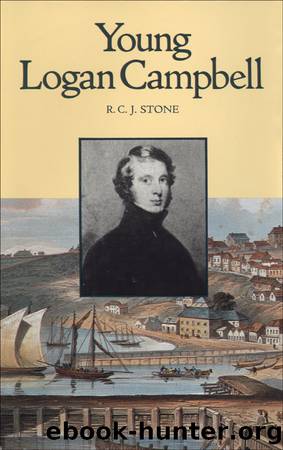Young Logan Campbell by R.C.J. Stone

Author:R.C.J. Stone [Stone, R. C. J.]
Language: eng
Format: epub
Tags: Biography
Publisher: Auckland University Press
Published: 1982-01-01T00:00:00+00:00
TEN
PRESENT ADJUSTMENTS AND FUTURE PLANS, 1849-51
CAMPBELL RETURNED to Scotland in a state of euphoria. Months of constant travel had stimulated him, introducing fresh places and people, enabling him to move in a new world whose pleasures he had never suspected. Having reached the age of thirty-one without encountering at first hand any works of art more substantial than prints and watercolours, he had suddenly become aware of refined standards of taste in art and architecture that he, with further leisure, travel, and application, could also acquire.
Three days back in the family circle, however, and he was deflated. Though, as a considerate son, he dared not admit as much to his parents, Edinburgh displeased him. Compared with other cities its pace was rustic: it âdoes savour of grass-grown streets.â1 Furthermore, the new family home at 2 Queen Street, if in keeping with the shrunken practice of the old doctor, was more cramped than the spacious Albany Street residence of his youth. Nor was it the family home that he remembered: Regina was no longer there. Loganâs gloom was deepened by the need to show pleasure he did not feel and by pangs of conscience about this self-same deception.
The dark mood was not dispelled when his parents, as they had long planned, took the reunited family as a treat upon a leisurely three-week holiday through part of the Trossachs by Loch Lomond.2 With the splendours of Alpine Switzerland still fresh in his mind, Campbell was bored by the modest lochs and hills (as he considered them) of the southern Highlands. His parents noted with reproachful surprise that instead of gazing upon and praising Ben Lomond their son buried his head in a novel. It was with relief that after less than a month in Scotland Campbell was able to flee Edinburgh to attend to urgent affairs of Brown & Campbell in London.3
Seven weeks in London using the offices of H. H. Willis & Coy as his base did little, however, to restore Campbellâs spirits. There was much agency and consignment work to attend to, involving correspondence with manufacturers, merchants, and above all Mr Gibson of St Andrews. Moreover, Campbellâs main task proved worrying and protracted.4 This was to dispose of a cargo of kauri spars sent by Brown & Campbell on the ship, the Indian, which they had chartered the year before at a high figure.5 This enterprise, which had been under discussion before Campbell left New Zealand, he had considered even then âa speculation of a very precarious natureâ.6 By the time the Indian sailed from the colony in October 1848 circumstances had begun to work strongly against the success of the venture. The threat of European war had receded and with it the likelihood of any increase in the Royal Navyâs demand for timber. Indeed a retrenching government was forcing the Admiralty to cut down on its purchases of spars. Campbell came up to London to find the Indianâs cargo in storage, still unsold and with little prospect of sale.
Download
This site does not store any files on its server. We only index and link to content provided by other sites. Please contact the content providers to delete copyright contents if any and email us, we'll remove relevant links or contents immediately.
| Military | Political |
| Presidents & Heads of State | Religious |
| Rich & Famous | Royalty |
| Social Activists |
Waking Up in Heaven: A True Story of Brokenness, Heaven, and Life Again by McVea Crystal & Tresniowski Alex(37040)
Empire of the Sikhs by Patwant Singh(22208)
We're Going to Need More Wine by Gabrielle Union(18112)
Hans Sturm: A Soldier's Odyssey on the Eastern Front by Gordon Williamson(17044)
Leonardo da Vinci by Walter Isaacson(11955)
The Radium Girls by Kate Moore(10947)
Educated by Tara Westover(7096)
Tools of Titans by Timothy Ferriss(7004)
How to Be a Bawse: A Guide to Conquering Life by Lilly Singh(6727)
The Last Black Unicorn by Tiffany Haddish(5095)
Permanent Record by Edward Snowden(5035)
The Rise and Fall of Senator Joe McCarthy by James Cross Giblin(4859)
Promise Me, Dad by Joe Biden(4480)
The Wind in My Hair by Masih Alinejad(4441)
The Crown by Robert Lacey(4127)
A Higher Loyalty: Truth, Lies, and Leadership by James Comey(4061)
The Iron Duke by The Iron Duke(3666)
Joan of Arc by Mary Gordon(3282)
How to be Champion: My Autobiography by Sarah Millican(3202)
